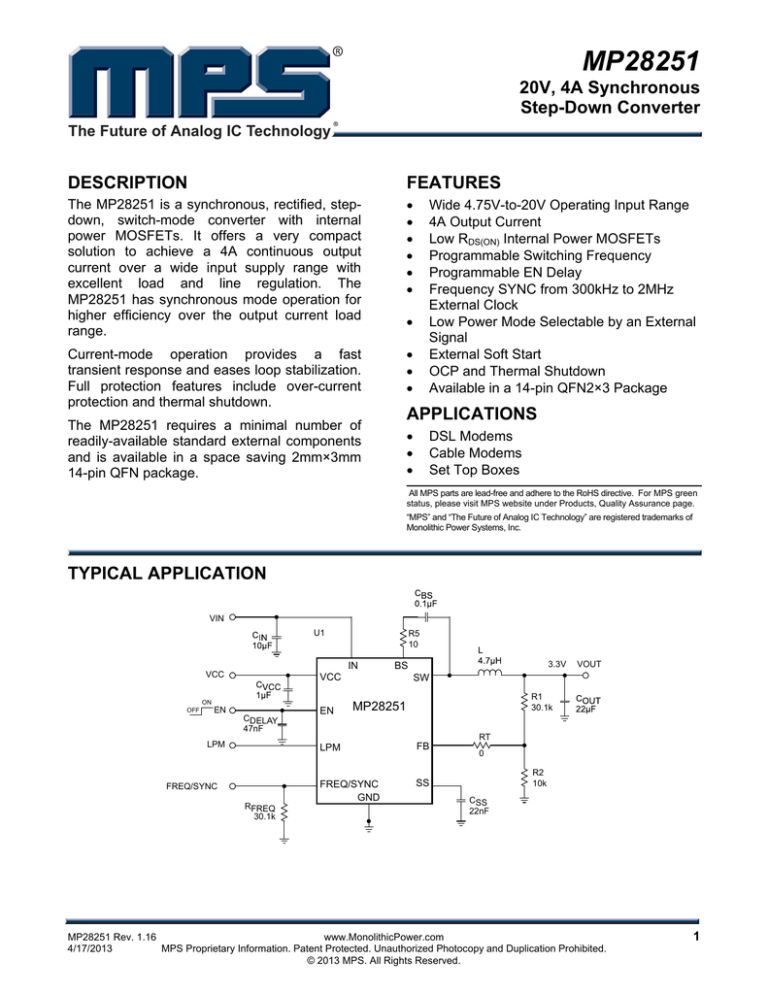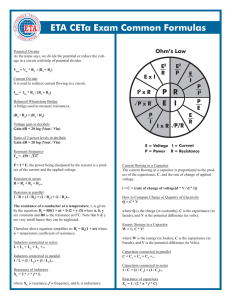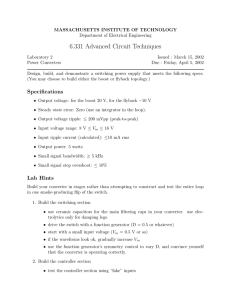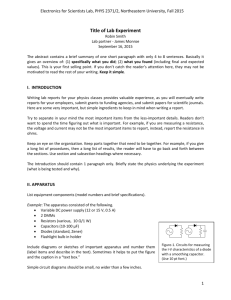
MP28251
20V, 4A Synchronous
Step-Down Converter
The Future of Analog IC Technology
DESCRIPTION
FEATURES
The MP28251 is a synchronous, rectified, stepdown, switch-mode converter with internal
power MOSFETs. It offers a very compact
solution to achieve a 4A continuous output
current over a wide input supply range with
excellent load and line regulation. The
MP28251 has synchronous mode operation for
higher efficiency over the output current load
range.
Current-mode operation provides a fast
transient response and eases loop stabilization.
Full protection features include over-current
protection and thermal shutdown.
Wide 4.75V-to-20V Operating Input Range
4A Output Current
Low RDS(ON) Internal Power MOSFETs
Programmable Switching Frequency
Programmable EN Delay
Frequency SYNC from 300kHz to 2MHz
External Clock
Low Power Mode Selectable by an External
Signal
External Soft Start
OCP and Thermal Shutdown
Available in a 14-pin QFN2×3 Package
APPLICATIONS
The MP28251 requires a minimal number of
readily-available standard external components
and is available in a space saving 2mm×3mm
14-pin QFN package.
DSL Modems
Cable Modems
Set Top Boxes
All MPS parts are lead-free and adhere to the RoHS directive. For MPS green
status, please visit MPS website under Products, Quality Assurance page.
“MPS” and “The Future of Analog IC Technology” are registered trademarks of
Monolithic Power Systems, Inc.
TYPICAL APPLICATION
VIN
U1
IN
VCC
ON
OFF
EN
R5
10
CDELAY
47nF
LPM
FREQ/SYNC
RFREQ
30.1k
EN
3.3V
BS
VCC
VOUT
SW
R1
30.1k
MP28251
LPM
FB
FREQ/SYNC
GND
SS
RT
0
R2
10k
CSS
22nF
MP28251 Rev. 1.16
www.MonolithicPower.com
4/17/2013
MPS Proprietary Information. Patent Protected. Unauthorized Photocopy and Duplication Prohibited.
© 2013 MPS. All Rights Reserved.
1
MP28251 – 20V, 4A SYNCHRONOUS STEP-DOWN CONVERTER
ORDERING INFORMATION
Part Number
MP28251GD*
Package
QFN14 (2×3mm)
Top Marking
ABM
* For Tape & Reel, add suffix –Z (eg. MP28251GD–Z);
PACKAGE REFERENCE
2x3 QFN14
ABSOLUTE MAXIMUM RATINGS (1)
Thermal Resistance
VIN ..................................................-0.3V to 22V
VSW ..................................................-0.3V to 23V
VBST ...................................................... VSW + 6V
(2)
All Other Pins ................................ -0.3V to 6V
Junction Temperature ...............................150°C
Lead Temperature ....................................260°C
(3)
Continuous Power Dissipation (TA = +25°C)
2x3 QFN14 ................................................ 1.8W
Junction Temperature
150°C
Operating Temperature.............. -40°C to +85°C
QFN14 (2x3mm) ..................... 70 ...... 15... °C/W
Recommended Operating Conditions
(4)
Supply Voltage VIN .........................4.75V to 20V
Output Voltage VOUT .........................0.8V to 17V
Operating Junction Temp. (TJ) -40°C to +125°C
(5)
θJA
θJC
Notes:
1) Exceeding these ratings may damage the device.
2) Please refer to page 9, Enable Control section, For absolute
maximum rating of EN pin.
3) The maximum allowable power dissipation is a function of the
maximum junction temperature TJ (MAX), the junction-toambient thermal resistance θJA, and the ambient temperature
TA. The maximum allowable continuous power dissipation at
any ambient temperature is calculated by PD (MAX) = (TJ
(MAX)-TA)/θJA. Exceeding the maximum allowable power
dissipation will cause excessive die temperature, and the
regulator will go into thermal shutdown. Internal thermal
shutdown circuitry protects the device from permanent
damage.
4) The device is not guaranteed to function outside of its
operating conditions.
5) Measured on JESD51-7, 4-layer PCB.
MP28251 Rev. 1.16
www.MonolithicPower.com
4/17/2013
MPS Proprietary Information. Patent Protected. Unauthorized Photocopy and Duplication Prohibited.
© 2013 MPS. All Rights Reserved.
2
MP28251 – 20V, 4A SYNCHRONOUS STEP-DOWN CONVERTER
ELECTRICAL CHARACTERISTICS
VIN = 12V, TA = 25°C, unless otherwise noted.
Parameters
Supply Current (Shutdown)
Supply Current (Quiescent)
HS Switch-On Resistance
LS Switch-On Resistance
Symbol
IIN
IIN
HSRDS-ON
LSRDS-ON
Switch Leakage
SWLKG
Current Limit
Oscillator Frequency
Maximum Duty Cycle
Sync Frequency Range
Feedback Voltage
Feedback Current
EN Input Low Voltage
EN Input High Voltage
EN Pin Pull-Up Current
VIN Under-Voltage Lockout
Threshold Rising
VIN Under-Voltage Lockout
Threshold Hysteresis
VCC Regulator
VCC Load Regulation
Thermal Shutdown
Soft Start Current
Thermal Shutdown Hysteresis
ILIMIT
fSW
DMAX
fSYNC
VFB
IFB
VILEN
VIHEN
IEN
Condition
VEN = 0V
VEN = 2V, VFB = 1V
VEN = 0V, VSW = 0V or
12V
Duty=40%
RSET=30k
VFB = 700mV
Min
Max
Units
μA
mA
mΩ
mΩ
0
10
μA
5.6
500
95
600
0.98
1.32
1.2
815
25
1.12
1.50
2.3
2
830
50
1.32
1.78
3.5
A
kHz
%
MHz
mV
nA
V
V
μA
4.0
4.25
4.5
V
400
90
0.3
800
VFB = 800mV
INUVVth
Typ
10
1
60
30
INUVHYS
870
mV
VCC
5
1
150
8
30
V
%
°C
μA
°C
ICC=5mA
TSD
ISS
TSD-HYS
MP28251 Rev. 1.16
www.MonolithicPower.com
4/17/2013
MPS Proprietary Information. Patent Protected. Unauthorized Photocopy and Duplication Prohibited.
© 2013 MPS. All Rights Reserved.
3
MP28251 – 20V, 4A SYNCHRONOUS STEP-DOWN CONVERTER
PIN FUNCTIONS
QFN 2×3mm
Pin #
1, 12,
13, 14
2, 11
3, 15
4
5
6
7
8
9
10
Name
Description
Ground. Connect these pins with larger copper areas to the negative terminals of the
input and output capacitors.
SW
Switch Output. Use wide PCB traces to make the connection.
Supply Voltage. The MP28251 operates from a 4.75V-to-20V input rail. Requires C1 to
IN
decouple the input rail. Use wide PCB traces and multiple vias to make the connection.
Enable. EN=1 to enable the MP28251. The EN pin sources 2.3μA. Place a capacitor
EN
from EN to GND for delayed start-up.
Low-Power Mode Input. An active-high signal enables low-power mode operation.
LPM
Connect LPM pin to GND to disable it and make the converter always operate in COM.
Feedback. Connect to the tap of an external resistor divider from the output to GND to
FB
set the output voltage.
Soft Start. Connect an external capacitor to program the soft-start time for the switchSS
mode regulator.
FREQ/ Switching Frequency Program Input. Connect a resistor from this pin to GND to set the
SYNC switching frequency. This pin also serves as a frequency-synchronous clock input.
Bias Supply. Decouple with 0.1µF capacitor. Decouple capacitor must be close enough
VCC
to VCC pin to increase noise immunity.
Bootstrap. Requires a capacitor connected between SW and BST pins to form a
BST
floating supply across the high-side switch driver.
GND
MP28251 Rev. 1.16
www.MonolithicPower.com
4/17/2013
MPS Proprietary Information. Patent Protected. Unauthorized Photocopy and Duplication Prohibited.
© 2013 MPS. All Rights Reserved.
4
MP28251 – 20V, 4A SYNCHRONOUS STEP-DOWN CONVERTER
TYPICAL PERFORMANCE CHARACTERISTICS
VIN = 12V, VOUT = 3.3V, L = 4.7µH, fS=500kHz, TA = +25°C, unless otherwise noted.
MP28251 Rev. 1.16
www.MonolithicPower.com
4/17/2013
MPS Proprietary Information. Patent Protected. Unauthorized Photocopy and Duplication Prohibited.
© 2013 MPS. All Rights Reserved.
5
MP28251 – 20V, 4A SYNCHRONOUS STEP-DOWN CONVERTER
TYPICAL PERFORMANCE CHARACTERISTICS (continued)
VIN = 12V, VOUT = 3.3V, L = 4.7µH, fS=500kHz, TA = +25°C, unless otherwise noted.
MP28251 Rev. 1.16
www.MonolithicPower.com
4/17/2013
MPS Proprietary Information. Patent Protected. Unauthorized Photocopy and Duplication Prohibited.
© 2013 MPS. All Rights Reserved.
6
MP28251 – 20V, 4A SYNCHRONOUS STEP-DOWN CONVERTER
TYPICAL PERFORMANCE CHARACTERISTICS (continued)
VIN=12V, VOUT=3.3V, L = 4.7µH, fS=500kHz, TA = +25°C, unless otherwise noted.
MP28251 Rev. 1.16
www.MonolithicPower.com
4/17/2013
MPS Proprietary Information. Patent Protected. Unauthorized Photocopy and Duplication Prohibited.
© 2013 MPS. All Rights Reserved.
7
MP28251 – 20V, 4A SYNCHRONOUS STEP-DOWN CONVERTER
FUNCTIONAL BLOCK DIAGRAM
Figure 1: Functional Block Diagram
MP28251 Rev. 1.16
www.MonolithicPower.com
4/17/2013
MPS Proprietary Information. Patent Protected. Unauthorized Photocopy and Duplication Prohibited.
© 2013 MPS. All Rights Reserved.
8
MP28251 – 20V, 4A SYNCHRONOUS STEP-DOWN CONVERTER
OPERATION
The MP28251 is a high-frequency, synchronous,
rectified, step-down, switch-mode converter
with internal power MOSFETs. It offers a very
compact solution to achieve 4A of continuous
output current over a wide input supply range
with excellent load and line regulation.
The MP28251 operates in a fixed-frequency,
peak-current–mode control to regulate the
output voltage. The internal clock initiates the
PWM cycle, turning on the integrated high-side
power MOSFET. The high-side MOSFET
remains on until its current reaches the value
set by the COMP voltage. When the power
switch is off, it remains off until the next clock
cycle starts. If, within 90% of one PWM period,
the current in the power MOSFET does not
reach the COMP set current value, the power
MOSFET will be forced to turn off.
Error Amplifier
The error amplifier compares the FB pin voltage
against the internal 0.8V reference (REF) and
outputs a current proportional to the difference
between the two. This output current charges or
discharges the internal compensation network
to form the COMP voltage, which controls the
power MOSFET current. The optimized internal
compensation network minimizes the external
component count and simplifies the control loop
design.
Internal Regulator
The 5V internal regulator powers most of the
internal circuitries. This regulator takes the VIN
input and operates in the full VIN range. When
VIN exceeds 5.0V, the output of the regulator is
in full regulation. When VIN is less than 5.0V,
the output decreases. The part requires a 0.1µF
ceramic decoupling capacitor.
Enable Control
The MP28251 has a dedicated enable control
pin (EN): pulling it high enables the IC, pulling it
low disables it.. Tie EN to VIN through a resistor
for automatic start up. EN must be pulled low to
disable the part.
The EN pin is clamped internally using a 6.7V
series-Zener-diode as shown in Figure 2.
Connect the EN input pin through a pullup
resistor to any voltage connected to the VIN pin
such that the pullup resistor limits the EN input
current to less than 100µA.
For example, connecting 12V to VIN, RPULLUP ≥
(12V – 6.7V)/100µA = 53kΩ.
Connecting the EN pin is directly to a voltage
source without any pullup resistor requires
limiting the amplitude of the voltage source to
below 6V to prevent damage to the Zener diode.
EN
Zener
6.7V typ.
EN LOGIC
GND
Figure 2: Zener Diode between EN and GND
The EN pin also features an internal 2.3μA
current source. Connect a capacitor to the EN
pin for delayed startup. When VIN exceeds the
input UVLO, an internal 2.3μA current source
charges the external capacitor. The external
capacitor connects to the non-inverting input of
a comparator. The part is enabled once the
capacitor voltage exceeds the 1.5V internal
reference voltage.
Frequency Synchronizing
The MP28251 can be synchronized to an
external clock with a range from 300kHz to
2MHz through the SYNC pin. The internal clock
rising edge is synchronized to the external clock
rising edge.
Low Power Mode
The MP28251 can operate in discontinuous
mode (DCM) and Pulse skip mode (PSM) under
light load to improve efficiency, featured as the
Low Power Mode. To enable Low Power Mode,
connect LPM pin to VCC pin or to a voltage
divider from VCC. To disable Low Power Mode,
connect LPM pin to ground and the converter
will always operate in CCM.
MP28251 Rev. 1.16
www.MonolithicPower.com
4/17/2013
MPS Proprietary Information. Patent Protected. Unauthorized Photocopy and Duplication Prohibited.
© 2013 MPS. All Rights Reserved.
9
MP28251 – 20V, 4A SYNCHRONOUS STEP-DOWN CONVERTER
When the LPM pin connects to VCC, the
inductor peak current in set internally which is
about 240mA for VIN=12V, VOUT=3.3V and
L=4.7uH. Peak inductor current also can be set
by connecting LPM pin to a voltage divider from
VCC with 2 external resistors. By program LPM
voltage, efficiency and output ripple can be
traded off and optimize. Higher LPM gives
higher peak inductor current thus more efficient
but more output ripple. To help select the LPM
voltage, the curve of inductor peak current vs.
low power mode voltage is shown in Page 5,
Typical Performance Characteristics section.
Under-Voltage Lockout (UVLO)
Under-voltage lockout (UVLO) protects the chip
from operating at insufficient supply voltage.
The MP28251’s UVLO comparator monitors the
output voltage of the internal regulator, VCC.
The UVLO rising threshold is 4.25V while its
falling threshold is 3.38V.
External Soft-Start
Connect a capacitor from the soft-start pin to
ground to adjust the soft-start time. When softstart begins, an internal 8μA current source
charges the external capacitor. The soft-start
capacitor connects to the non-inverting input of
the error amplifier. The soft-start period lasts
until the voltage on the soft-start capacitor
exceeds the 0.815V reference. At this point the
reference voltage takes over at the noninverting error-amplifier input. The soft-start
time can be calculated as follows:
t SS (ms)
0.815V CSS (nF)
8A
If the output of the MP28251 is pre-biased to a
certain voltage during startup, the IC will disable
the switching of both high-side and low-side
switches until the voltage on the internal softstart capacitor exceeds the sensed output
voltage at the FB pin.
Over-Current-Protection
The MP28251 has a hiccup mode over-current
limit for when the inductor current peak value
exceeds the set current limit threshold.
When the output voltage drops below 70% of
the reference, and inductor current exceeds the
current limit, the MP28251 will enter soft-start
mode and retry until the fault is removed. This
is especially useful to ensure system safety
under fault conditions.
The latch-off function is disabled during softstart duration.
Thermal Shutdown
Thermal shutdown prevents the chip from
operating at exceedingly high temperatures.
When the silicon die temperature exceeds
150°C, it shuts down the whole chip. When the
temperature falls below its lower threshold,
typically 120°C, the chip is enabled again.
Floating Driver and Bootstrap Charging
An external bootstrap capacitor powers the
floating power MOSFET driver. This floating
driver has its own UVLO protection. The
UVLO’s rising threshold is 2.2V with a
hysteresis of 150mV. The bootstrap capacitor
voltage is regulated internally by VIN through
D1, M1, C4, L1 and C2 (Figure 3). If (VIN-VSW)
exceeds 5V, U1 regulates M1 to maintain a 5V
BST voltage across C4.
D1
VIN
M1
BST
5V
U1
C4
VOUT
SW
L1
C2
Figure 3: Internal Bootstrap Charging Circuit
Startup and Shutdown
If both VIN and EN exceed their respective
thresholds, the chip is enabled. The reference
block starts first, generating a stable reference
voltage and currents, and then the internal
regulator is enabled. The regulator provides a
stable supply for the remaining circuitries.
Three events can shut down the chip: EN low,
VIN low and thermal shutdown. In shutdown, the
signaling path is first blocked to avoid any fault
triggering. The COMP voltage and the internal
supply rail are then pulled down. The floating
driver is not subject to this shutdown command.
MP28251 Rev. 1.16
www.MonolithicPower.com
4/17/2013
MPS Proprietary Information. Patent Protected. Unauthorized Photocopy and Duplication Prohibited.
© 2013 MPS. All Rights Reserved.
10
MP28251 – 20V, 4A SYNCHRONOUS STEP-DOWN CONVERTER
APPLICATION INFORMATION
COMPONENT SELECTION
Setting the Output Voltage
The external resistor divider sets the output
voltage (see Typical Application on page 1).
The feedback resistor, R1, also sets the
feedback loop bandwidth with the internal
compensation capacitor. Choose R1 around
10kΩ, then R2 is:
R2
0.815V
VOUT (VIN VOUT )
VIN IL fOSC
Where ΔIL is the inductor ripple current.
Choose the inductor ripple current to be
approximately 30% of the maximum load
current. The maximum inductor peak current is:
IL(MAX ) ILOAD
R1
VOUT
L1
1
The T-type network (shown in Figure 4) is
highly recommended when VOUT is low.
R8
Under light-load conditions (below 100mA), use
a larger inductor for improved efficiency.
Setting the Switching Frequency
An external resistor, RFREQ, from the FREQ pin
to GND sets the MP28251’s oscillating
frequency. The value of RFREQ can be
calculated from:
R FREQ (k)
Figure 4: T-Type Network
Table 1 lists the recommended T-type resistors
value for common output voltages.
Table 1: Resistor Selection for Common Output
Voltages
VOUT (V)
R1 (kΩ)
R2 (kΩ)
R8 (kΩ)
1.05
3.09(1%)
10(1%)
120(1%)
1.2
4.99(1%)
10(1%)
75(1%)
1.8
10(1%)
8.06(1%) 49.9(1%)
2.5
10(1%)
4.75(1%) 24.9(1%)
3.3
10(1%)
3.16(1%)
0(1%)
5
10(1%)
1.91(1%)
0(1%)
Selecting the Inductor
Use a 1µH-to-10µH inductor with a DC current
rating of at least 25% percent higher than the
maximum load current for most applications.
Select an inductor with a DC resistance less
than 15mΩ for best efficiency. Use the following
equation to derive the inductor value for most
designs.
I L
2
15000
fS (kHz )
Selecting the Input Capacitor
The input current to the step-down converter is
discontinuous, and therefore requires a
capacitor to supply the AC current to the stepdown converter while maintaining the DC input
voltage. Use low-ESR capacitors for the best
performance. Ceramic capacitors with X5R or
X7R dielectrics are highly recommended
because of their low ESR and small
temperature coefficients. For most applications,
a 22µF capacitor is sufficient.
Since the input capacitor (C1) absorbs the input
switching current it requires an adequate ripple
current rating. The RMS current in the input
capacitor can be estimated by:
I C1 ILOAD
VOUT VOUT
1
VIN
VIN
The worse case condition occurs at VIN = 2VOUT,
where:
IC1
ILOAD
2
MP28251 Rev. 1.16
www.MonolithicPower.com
4/17/2013
MPS Proprietary Information. Patent Protected. Unauthorized Photocopy and Duplication Prohibited.
© 2013 MPS. All Rights Reserved.
11
MP28251 – 20V, 4A SYNCHRONOUS STEP-DOWN CONVERTER
For simplification, choose the input capacitor
whose RMS current rating is greater than half of
the maximum load current.
The input capacitor can be electrolytic, tantalum
or ceramic. When using electrolytic or tantalum
capacitors, place a small, high-quality ceramic
capacitor (e.g. 0.1μF) as close to the IC as
possible. When using ceramic capacitors, make
sure that they have enough capacitance to
provide sufficient charge to prevent excessive
voltage ripple at the input. The input voltage
ripple caused by the capacitance can be
estimated by:
VIN
ILOAD
V
V
OUT 1 OUT
fS C1 VIN
VIN
Selecting the Output Capacitor
The device requires an output capacitor (C2) to
maintain the DC output voltage. Use ceramic,
tantalum, or low ESR electrolytic capacitors.
Use low-ESR capacitors to limit the output
voltage ripple. Estimate the output voltage
ripple with:
VOUT
VOUT VOUT
1
fS L1
VIN
1
RESR
8
f
C2
S
Where L1 is the inductor value and RESR is the
equivalent series resistance (ESR) value of the
output capacitor.
For ceramic capacitors, the impedance at the
switching frequency is dominated by the
capacitance. The output voltage ripple is mainly
caused by the capacitance. For simplification,
the output voltage ripple can be estimated by:
ΔVOUT
V
VOUT
1 OUT
VIN
8 fS 2 L1 C2
For tantalum or electrolytic capacitors, the ESR
dominates the impedance at the switching
frequency. For simplification, the output ripple
can be approximated to:
ΔVOUT
MP28251 can be optimized for a wide range of
capacitance and ESR values.
External Bootstrap Diode
An external bootstrap diode can enhance the
efficiency of the regulator, given the following
conditions:
VOUT is 5V or 3.3V; and
Duty cycle is high: D=
VOUT
>65%
VIN
Use an external BST diode from the VCC pin to
the BST pin—as shown in Figure 5—for such
cases.
BST
MP28251
SW
External BST Diode
IN4148
VCC
CBST
L
COUT
Figure 5: Optional Bootstrap Diode
The recommended external BST diode is
IN4148, and the BST capacitor is 0.1µF to 1μF.
PC Board Layout
This PCB board layout is referring to the
schematic in Figure 6.
Place the high-current paths (GND, IN and SW)
very close to the device with short, direct and
wide traces. The input decoupling capacitor
needs to be placed as close as possible to the
IN and GND pins. The VCC decoupling
capacitor needs to be placed as close as
possible to the VCC pin and multiple VIAs
should be used on both the ground side of the
VCC decoupling capacitor and the GND pins to
connect to the inner and bottom ground plane.
Place the external feedback resistors next to
the FB pin. Keep the switching node SW short
and away from the feedback network.
VOUT
V
1 OUT RESR
fS L1
VIN
The characteristics of the output capacitor also
affect the stability of the regulatory system. The
MP28251 Rev. 1.16
www.MonolithicPower.com
4/17/2013
MPS Proprietary Information. Patent Protected. Unauthorized Photocopy and Duplication Prohibited.
© 2013 MPS. All Rights Reserved.
12
MP28251 – 20V, 4A SYNCHRONOUS STEP-DOWN CONVERTER
MP28251 Rev. 1.16
www.MonolithicPower.com
4/17/2013
MPS Proprietary Information. Patent Protected. Unauthorized Photocopy and Duplication Prohibited.
© 2013 MPS. All Rights Reserved.
13
MP28251 – 20V, 4A SYNCHRONOUS STEP-DOWN CONVERTER
TYPICAL APPLICATION CIRCUITS
VIN
GND
R5
10
4.75-20V
R4
23.2k
3
9
VCC
R9
37.5k
4
EN
C5
47nF
R3
10k
5
LPM
C8
10pF
U1
IN
VCC
10
BS
2
SW
11
SW
8
R10
30.1k
3.3V/4A
VOUT
MP28251
C6
27pF
EN
FB
LPM
GND
R8
0
FREQ/SYNC
GND
1,12 13,14
SS
R6
0
6
R11
4.99k
FREQ/SYNC
SW
R1
10k
R7
51
R2
3.16k
7
C7
22nF
SS
Figure 6: 500kHz, 3.3V Output at 4A Step-Down Converter
MP28251 Rev. 1.16
www.MonolithicPower.com
4/17/2013
MPS Proprietary Information. Patent Protected. Unauthorized Photocopy and Duplication Prohibited.
© 2013 MPS. All Rights Reserved.
14
MP28251 – 20V, 4A SYNCHRONOUS STEP-DOWN CONVERTER
PACKAGE INFORMATION
QFN14 (2mmx3mm)
NOTICE: The information in this document is subject to change without notice. Users should warrant and guarantee that third
party Intellectual Property rights are not infringed upon when integrating MPS products into any application. MPS will not
assume any legal responsibility for any said applications.
MP28251 Rev. 1.16
www.MonolithicPower.com
4/17/2013
MPS Proprietary Information. Patent Protected. Unauthorized Photocopy and Duplication Prohibited.
© 2013 MPS. All Rights Reserved.
15



